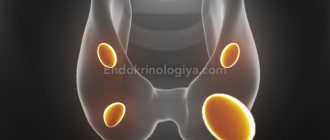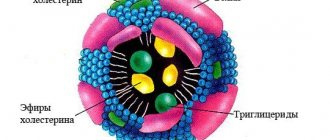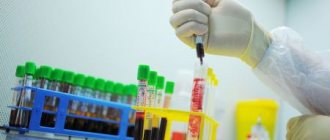Using laboratory diagnostic methods, doctors evaluate the functioning of internal organs; the GGT indicator in a biochemical blood test is a marker of damage to the biliary tract and liver. Studies aimed at studying GGT are prescribed if diseases of the hepatobiliary system are suspected. They are used to monitor treatment and detect the transition of the disease to a chronic form. A change in the activity of this enzyme in the blood plasma may indicate alcoholism, malignant tumors, taking narcotic substances, medications that have become a direct or indirect cause of liver damage.
To identify the problem at an early stage, and not to let the pathological process lead to irreparable consequences, you should regularly visit a doctor, conduct blood tests, know what GGT is, what its normal values are.
GGT - what is it?
Not all medical terms are understandable to people not involved in this field of activity. Meanwhile, explaining in simple terms what GGT is is not so difficult. GGT, GGT, GGTP, gamma-GT, γ-GTP are abbreviations for gamma-glutamyltransferase. This is the name of the microsomal enzyme found in cells. It ensures the occurrence of biochemical processes (acting as a catalyst), amino acid reactions, and is important for the metabolism of glutathione, the main antioxidant in the human body.
This enzyme has other names - gamma-glutamyl transpeptidase. This word is synonymous with the term gamma glutamyl transferase. You should be aware that any of the above abbreviations may be indicated in the prescription for biochemical analysis (GGT - short for English Gamma-glutamyltransferase, γ-GTP - for γ-Glutamyltranspeptidase).
Where is gamma glutamyl transferase located?
Accumulates in parenchymal organs, mainly in the kidneys, in significant quantities in the liver, bile ducts, and pancreas. A small number is found in the intestines and brain. In the heart, lungs, and skeletal muscles, its concentration tends to zero. In blood plasma, enzyme activity is normally insignificant - 4-6 times less than in urine. Its presence here is explained by the excretion of gamma-glutamyltransferase formed in the liver and the natural death of old cells in which the enzyme is localized.
Due to such normal processes, GGT in the blood is not zero. If the analysis showed that GGT is elevated, then this indicates massive cell death or problems with bile secretion, which led to an increase in the levels of compounds in the blood that are normally excreted along with bile.
Effects of alcohol
The release of GGT is directly related to the consumption of alcohol - even when determining the initial high levels of the enzyme in the blood, giving up alcohol reduces the GGT content by 2 times after 10 days. If after a month the GGT level returns to normal, this means there is no pathology. If the indicators are close to exceeding the norm, it is worth thinking about completely giving up alcohol, since it is this that causes alcoholism and such serious conditions as cirrhosis, injuries while intoxicated, and delirium tremens.
In the case of a single alcohol intoxication, a period of abstinence is sufficient for the indicators to return to normal.
A test for GGT, done in conjunction with other studies of liver enzymes (ALT, AST), can determine not only alcoholism, but also alcoholic steatohepatitis - an inflammatory process with the parallel formation of areas of necrosis under the influence of ethanol metabolic products.
In other words, a penchant for drinking alcohol that has not yet developed into alcoholism. Some companies have made such a test mandatory during a medical examination, and in case of a positive result, it becomes a reason for recognizing professional unsuitability. Treatment of the identified pathology depends on the stage of the disease and is carried out only under the supervision of a doctor.
What affects GGT levels?
When deciphering the results of blood biochemistry for GGT, the age component should be taken into account - in infancy and childhood, enzyme levels exceed normal values for adults. Thus, the GGT value of 90 is within the normal range for newborns and infants aged 1-7 months. If such a concentration of the enzyme is detected in adults or older children, then increased activity of gamma-glutamyltransferase is diagnosed.
The gender of the subject is also taken into account: the rate of GGT activity in men is significantly higher than in women (the difference is up to 50% and is ensured by the influence of male sex hormones and the secretion of the enzyme gamma-glutamyltransferase by the prostate gland). A similar pattern begins to be observed after reaching puberty.
The results of the GGT enzyme test are also affected by:
- diet – excess salty, sweet foods;
- deficiency of vitamins and minerals;
- body mass;
- presence of bad habits – smoking, drinking alcohol, substance abuse;
- pregnancy (first weeks);
- drug therapy;
- use of hormonal contraception.
Decoding the results
Only a doctor can decipher the test result. Based on them, he can determine or deny the presence of pathology. As a rule, an increase in the level of this enzyme is observed in chronic and acute hepatitis, cholestasis, pancreatitis, alcohol dependence, and oncology. The norm for women over 17 years of age is 6-42 units/l. If the sample is more than 50 times higher than normal, and all other enzymes are normal, then the patient has chronic alcoholism.
Article on the topic:
What is hepatitis C? How is it transmitted? Symptoms and treatment.
In heavy smokers and overweight people, the level of gamma HT can be exceeded by 50%.
Enzyme content standards
Normal values vary greatly by age. Laboratory test results should be interpreted based on the standards indicated on the GGT analysis form. Each laboratory, in accordance with internal regulatory standards, establishes and officially approves its reference ranges for a specific gender and age. The reason that the limits of norms may vary is due to differences in the equipment used and the blood analysis technique used. The content level is indicated in international units, designated IU or ED, per 1 liter of blood plasma. For reference, the table shows approximate data on the level of the GGT enzyme.
| Age | Reference limits (upper limit of normal) Female / Male |
| up to 6 months | 204 |
| 7-12 months | 34 |
| 2-6 years | 23 |
| 7-12 years | 19 |
| 13-17 years old | 38 / 52 |
| adults | 39 / 66 |
Reasons for increased enzyme levels
If there are elevated GGT values in a blood test, what could this mean? A doctor of appropriate specialization must determine the cause of changes in enzyme concentration, establish a diagnosis, and choose treatment tactics. When interpreting the results, the following are taken into account:
- influence of related factors;
- the magnitude of deviation from the norm;
- the content in the blood of other enzymes used to assess liver function - AST, AlAt, SDH, alkaline phosphatase, etc.;
- results of a complete examination of the body.
So, if blood biochemistry shows that GGT is increased significantly (5 times or more), then they suspect:
- cholestatic syndrome, cholangitis;
- the appearance of stones in the intrahepatic ducts;
- neoplastic changes in the liver;
- obstruction of the bile ducts, obstructive jaundice, intrahepatic or extrahepatic obstruction;
- inflammation of the gallbladder - cholecystitis;
- pancreatitis;
- alcoholism (even a single dose in high doses for several hours or days increases the concentration of GGT);
- alcoholic or primary biliary cirrhosis;
- poisoning with hepatotoxic substances - drugs, poisons;
- pancreatic tumors, liver damage by metastases.
The GGT test is the most sensitive marker because a change in values is observed even at an early stage of the disease. A moderate increase in GGT may indicate the presence of:
- infectious hepatitis;
- acute hepatitis of non-infectious nature;
- hepatocyte cytolysis;
- fatty hepatosis;
- diabetic ketoacidosis – a complication of diabetes mellitus;
- obesity.
High GGT is often caused by diseases of other organs containing this enzyme. Increased values are found in renal amyloidosis, infectious mononucleosis, chronic glomerulonephritis in the acute phase, renal pyelonephritis, chronic obstructive pulmonary disease, cancer of the prostate, breast, lungs or abdominal organs, after kidney transplantation.
It was found that serum GGT activity also increases during acute myocardial infarction and CHF. Due to the variety of possible diagnoses, it is difficult to independently decipher a blood test - a comprehensive examination and medical education are required.
Other possible reasons
Regular examinations and blood tests are recommended for anyone undergoing long-term treatment. Many tablets cause cytolysis (cell death) of the liver. This provokes the release of large amounts of liver enzymes into the blood. In women, this often happens when taking a course of estrogens and corticosteroids. The following gives the same effect:
- drugs for tuberculosis;
- a number of antibiotics, especially tetracyclines;
- barbiturates;
- neuroleptics;
- chemotherapy;
- non-steroidal anti-inflammatory drugs.
For treatment, you should take a course of hepatoprotectors - Essentiale, Heptral. All poisons, including alcohol, have a toxic effect on the liver. In chronic alcoholism, the amount of the enzyme can always be increased, and even after quitting alcohol it does not return to normal immediately. Among the rarer reasons for the increase in gamma HT in women are:
- systemic lupus erythematosus;
- Infectious mononucleosis;
- acute pyelonephritis;
- glomerulonephritis;
- kidney tumors;
- myocardial infarction;
- heart failure.
In some cases, the enzyme is elevated in thyrotoxicosis - hyperfunction of the thyroid gland. All of these pathologies do not occur without additional symptoms and are easily identified during examination.
Reasons for reducing GGT
Deviation of the indicator from the norm to a lesser extent is less common; in most cases, this condition does not need correction. The doctor’s task is to cure the underlying disease that caused the decrease in the concentration of gamma-glutamyltransferase in the blood. If the result does not fall within the lower limits of the norm, this may be a consequence of:
- acquired or hereditary hypothyroidism – lack of thyroid hormone;
- autoimmune thyroiditis;
- lack of iodine in food;
- consuming large doses of ascorbic acid.
What are the dangers of deviations from the norm?
A high level of the GGT enzyme in the blood is not dangerous in itself. A pathological process that provokes an increase in the concentration of gamma-glutamyltransferase poses a threat to human health and even life. This protein is the first to respond to the destruction of liver cells and blockage of the bile ducts. Moreover, to determine the level of danger, the following statement is true: the greater the deviation of the value from the upper limit of the norm, the more severe the disease.
If the analysis reveals a low concentration of GGT in the blood plasma, then there is no health risk in this case. But this result of blood biochemistry serves as a reason for diagnosing the functions of the thyroid gland, determining the level of thyroid-stimulating hormone produced by the pituitary gland and the main thyroid hormones - T3 and T4. They coordinate the work of the digestive, reproductive, cardiovascular and other systems of the body.
Causes
As already mentioned, increased gamma-GT levels may be associated with cholestasis. The disease is characterized by congestion in the gallbladder. In this case, the enzyme concentration can increase very significantly - 5 times or more. If bile stagnation is associated with liver disease, doctors talk about intrahepatic cholestasis, in which case the following pathologies may be the causes:
- viral hepatitis;
- cirrhosis;
- sclerosing cholangitis;
- toxic damage from chemical compounds.
Extrahepatic cholestasis is called if a failure of bile excretion is observed in the extrahepatic ducts. This may be due to the following diseases:
- formation of stones in the bile ducts;
- tumor processes in the ducts;
- Oncology of the stomach or head of the pancreas, the tumor presses on the common bile duct.
The death of liver cells leads to the fact that the enzyme ends up in the general blood stream. Cytolysis is the name of this pathology. It is observed with toxic or viral liver damage. The influence of autoimmune or systemic diseases, for example, lupus erythematosus, is also possible.
Article on the topic:
What is Gilbert's disease? Causes, symptoms and treatment
Hepatotoxic poisons can also cause liver damage:
- cyanides;
- arsenic;
- phenol;
- bacterial toxins;
- pesticides;
- toxins from the fungus toadstool.
But, of course, the hepatitis B and C viruses play the main role in liver destruction.
Alcohol dependence is also a common cause of increased gamma TG. Alcohol enhances the production of gamma GT.
Important! If you stop drinking alcohol-containing products, the gamma-GT level decreases by 50% within 10 days.
In the absence of adequate treatment, alcohol dependence can develop into alcoholic liver disease, resulting in fatty hepatosis - fatty infiltration of the organ, which will lead to atrophy of liver cells. These phenomena are already irreversible, and the patient cannot be saved.
With oncology in the liver, as well as the presence of metastases, the activity of the enzymes discussed also increases. In this case, the cause is several factors - stagnation inside the ducts, death of cellular structures, toxic effects of cancer intoxication. During the period of remission, a decrease in concentration is observed.
As for other reasons, they may be as follows:
- inflammatory process in the pancreas;
- diabetes mellitus, since it is directly related to pancreatic diseases;
- renal pathologies;
- injuries;
- neurological diseases;
- heart failure in severe form - congestion may develop, and as a result, cardiac cirrhosis of the liver;
- brain pathologies;
- extensive burns - in this case, the maximum concentration of the enzyme is observed after 10 days;
- hyperfunction of the thyroid gland;
- taking hormonal drugs.
When is the test ordered?
A referral for analysis to the laboratory can be given by a general practitioner or local therapist, as well as a highly specialized doctor - hepatologist, infectious disease specialist, hematologist, gastroenterologist, narcologist. A biochemical blood test to determine the level of Gamma-glutamyl transpeptidase is carried out for preventive purposes; it is included in routine medical examinations, a list of measures prescribed in preparation for surgery. An indication for the test is also the appearance in patients of alarming symptoms indicating liver pathology or a disorder of the biliary system.
These characteristic features are:
- icteric discoloration of the skin, whites of the eyes, mucous membranes;
- general weakness, fatigue;
- skin itching;
- discolored stool;
- the appearance of dark urine;
- frequent attacks of nausea;
- lack of appetite;
- profuse vomiting;
- pain in the right hypochondrium, abdominal area.
Indications for the study are also:
- liver health assessment;
- suspicion of neoplasms;
- identification of dysfunction of the gallbladder, ducts, detection of bile stagnation;
- screening for alcohol abuse;
- monitoring the course of cancer;
- determining the prognosis in terms of recovery after myocardial infarction;
- the need to establish the exact cause of the increased activity of the protein enzyme ALP (alkaline phosphatase);
- assessment of the hepatotoxic effect of medications taken;
- monitoring the effectiveness of therapy.
Preparing for analysis
To avoid false indicators in the final results table, it is recommended to follow preparation measures. By following the rules listed below, the results will be the most reliable, which will help to correctly diagnose or refute the disease.
- Blood is donated on an empty stomach. To avoid deviations in blood counts caused by activation of enzymes due to food intake.
- Refuse to eat fatty, highly salted, spicy, overcooked foods that are difficult for the body for at least twenty-four hours (preferably forty-eight hours).
- It is recommended to give up physical activity two days in advance, since physical effects on the body also affect the final results;
- A visit to a sauna, steam bath, or hot bath the day before can lead to fluctuations in normal values. You should avoid visiting places where the body is exposed to thermal effects;
- Limit alcohol intake and cigarette consumption at least 24 hours before the upcoming test;
- Stop using medications at least two days before the test. Drugs of certain groups can affect the parameters of a biochemical blood test.
Come to donate blood 10-15 minutes in advance. This is necessary so that the body calms down, shortness of breath goes away, and the body acclimatizes to the temperature conditions of the room (especially after a cold street). If you are very hungry, it is better to take food with you and satisfy your hunger immediately after blood collection.
Preparing to take the Gamma-glutamyl transpeptidase test
The patient should be instructed about the preparatory measures by the attending physician. He tells you what factors (medicines, oral contraceptives) can distort the result of a biochemical analysis and what should be done to ensure that the data obtained during the study are reliable. Standard training includes:
- Ensuring blood donation on an empty stomach - it is advisable not to eat food for 8-12 hours, do not overeat at the last meal, avoid fatty, pickled, spicy foods, and smoked foods. Fasting for more than 14 hours is not recommended. You are allowed to drink water (still).
- Avoid physical activity, emotional stress, and stressful situations on the eve of blood collection.
- Abstain from drinking alcoholic beverages. The restriction period must be at least 3-5 days.
- Stop smoking – at least 30 minutes in advance. before the procedure.
How is biochemical analysis for GGT/GGTP performed?
The biomaterial for research is blood serum (from 1 ml.). Venous and capillary blood is used. The sampling is performed from the vein of the elbow or another vein accessible for fixation. A tourniquet is applied above the puncture site, and the skin area is treated with an antiseptic. The collected whole blood is transfused into a test tube and then, subject to a certain temperature, delivered to a biochemical laboratory (within 2 hours).
During transportation and storage, care must be taken not to cause hemolysis of the blood sample. There are several methods for determining GGT activity; each laboratory uses its own method. The period for completing the study and issuing the result presented in numerical form is from 3-5 hours to 1 day. The form issued to the patient or doctor who wrote out the referral for biochemical analysis indicates the value obtained during the study, the unit of measurement and the variant of the norm.
Enzyme level correction
Increased GGT activity indicates the development of the disease. The way to reduce the level of the enzyme in the blood plasma is to prescribe competent treatment to eliminate the provoking factor. Medicines and therapeutic procedures are prescribed by a doctor after a comprehensive examination of the patient (to eliminate the possibility of error) and an accurate diagnosis. If endocrine system dysfunction is not detected with low GGT, it is recommended to include iodine-rich foods in the diet as a treatment.
How you can lower GGT yourself
Doctors do not recommend trying to reduce the concentration of Gamma-glutamyl transpeptidase by taking any medications or traditional medicine. Diseases that provoke an increase in this indicator in the blood are quite serious; they require timely and adequate therapy. This will help avoid worsening the disease. Only an experienced doctor can choose the right treatment tactics.
To speed up the process of normalizing the biochemical composition of the blood and improving treatment results, the patient can:
- exclude alcohol, smoking;
- reduce weight;
- eat enough, give up unhealthy foods (fried, smoked, flour, spices and pickles, soda);
- include more vegetables (pumpkin, carrots, spinach are healthy) and fruits (citrus fruits, apricots) in your diet;
- normalize the drinking regime, replace coffee and tea with clean water;
- take vitamins, mineral complexes (with the approval of a doctor);
- strengthen the immune system;
- to walk outside.
If you start treatment at an early stage of the disease, the prognosis is quite favorable.
Increased GGTP - Gamma-glutamyl transpeptidase in liver diseases
Gamma-glutamyl transferase (gamma-glutamyl transpeptidase) catalyzes the transfer of gamma-glutamyl to an amino acid or peptide. GGTP is a membrane-bound enzyme.
Changes in GGTP activity in serum are of great diagnostic importance for diseases of the liver and hepato-biliary tract. This enzyme is more sensitive to disorders in liver cells than ALT, AST, and alkaline phosphatase.
GGTP is diagnostically ambiguous. At least 5 processes cause an increase in its activity in the blood:
— fatty liver degeneration — Fatty hepatosis
- necrosis of liver cells;
- violation of the outflow of bile - cholestasis;
- alcohol intoxication;
- tumor growth in the liver;
- drug-induced liver damage.
This etiological variety of mechanisms for increasing GGTP requires a very careful and thorough assessment of the causes of this hyperenzyme. The discovery of high GGTP activity forces us to look for the reason for this increase. As a “screening” test and monitoring the course of a known pathological process, the study of GGTP is literally irreplaceable in clinical significance.
GGTP is especially sensitive to the effects of long-term alcohol consumption on the liver. In alcohol abusers, serum GGTP levels correlate with the amount of alcohol consumed. The test is especially valuable for monitoring treatment of alcoholism. Stopping alcohol intake reduces enzyme activity by approximately 50% within 10 days.
GGTP activity is used to determine whether liver cells are damaged and is usually elevated in 90% of cases of liver disease. In most cases, in such patients there is an increase in the activity of ALT and GGTP in the blood. An isolated increase in GGTP activity is observed in 6-20% of patients with pathology of the hepatobiliary system.
In acute hepatitis, GGTP activity increases earlier than ALT activity. At the peak of the disease, GGTP activity is lower (increased 2-5 times) than ALT activity and normalizes much more slowly. This allows the use of GGTP as a monitoring of the patient’s recovery.
An increase in GGTP activity by more than 3 times is caused by anticonvulsant drugs, fatty liver degeneration and heart failure.
The highest GGTP activity (5-30 times higher than the reference interval) is observed with intra- and extrahepatic cholestasis. Slightly lower values of enzyme activity are recorded in primary liver tumors and liver metastases. A persistent and long-term recorded increase in GGTP may be the only clinical and laboratory sign of metastatic liver disease.











